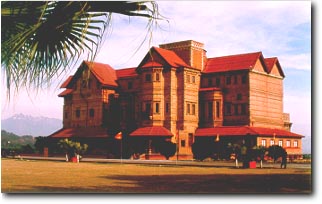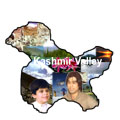|
|
Jammu
District
Jammu
is the second largest city in the state of Jammu and Kashmir.
It's 580 km from Delhi and 290 km from Srinagar on the south-eastern
slopes of the Siwalik Range. Jammu is perched on a hilltop
beside the Tawi River.

A new town
sprawls away from the hillside and extends for some distance
across the other side of the river. In winter Jammu become the
headquarters of the Jammu & Kashmir administration (as it
has done since the time of the Dogra rulers) and many Kashmiris
move there then because the temperature does not drop below
5oC. Summer can be uncomfortably hot (over 40oC) due to the
city's low altitude (300 meters), and humid, unpleasant conditions
also bring on plagues of gnats.
You can hear Urdu, Punjabi, English, Kashmiri, Hindi and Dogri
spoken in Jammu. Despite its mix of cultures, languages
and religions the city is not of great interest to tourists.
Most travellers tend to use it as an overnight stop on
the way to Kashmir. Unless you fly you will almost certainly
pass through Jammu on your way to Kashmir.
Legend has it that the city was founded by Jamboo Loochen about
three thousand years ago. The Raja was hunting in the
area, away from his capital city of Bahu, when he came across
a lion and a goat drinking from the same pound. The Shivadawala
Shrine now stands on this spot in the city. Jammu is known
as 'the city of temples' because of its many shrines with soaring
golden shikhars, or spires. The recorded history of Jammu begins
from the time of the Dogra rulers in the early 19th century,
although there are many other shrines and temples in and around
the city that date from earlier years.
In 1846, at the conclusion of the First Siks war, the treaties
of Lahore and Amritsar resulted in the Dogra ruler of Jammu
being made Maharaja of an ill-defined Himalayan Kingdom, eastward
of the river Indus and westward of the river Ravi.'
The British created this Kingdom as part of a complex political
buffer zone between their Indian Empire and China and Russia.
It was the lack of definition of these states - the forerunner
of Jammu and Kashhmir - that caused the continuing disputes
with Russia and China over territory.
For
the Maharaja Gulab Sing, the appointed head of the state, the
treaty concluded almost 25 years of fighting and negotiation
with the small hill tribes along the northern border of the
Sikh empire, centred on the Punjab. The region remained
under Dogra rule until the partition of India and Pakistan in
1947 when Hari Singh, the then Maharaja of Kashmir, and the
state of Jammu and Kashmir was bornin 1947.
Historical Placesand Monuments
Bahu Fort
It is a renowned historical temple of Goddess Mahakali popularily
known as Bawe-Wali Mata. The fort overlooks the river Tawi flowing
placidly down the Jammu City.
Mubarak Mandi Complex
The complex is housing 76 government offices and courts. The
complex has a history as old as 150 years back. It was a royal
residence of Dogra rulers. The palaces are built as a group
of buildings around the courtyard. Successive Dogra rulers added
to the complex in size. The buildings were used as the residences
of the royal Dogra families. The complex has halls and galleries
which were used for official functionsand public events.
Amar Mahal Museum
Amar Mahal Museum is a beautiful palace of red sand stone which
stands amidst most picturesque horizons of Jammu. Once the residential
palace of Raja Amar Singh, the palace has been converted into
a museum and is looked after by Hari-Tara Charitable trust.
The museum still has the golden throne on which Maharaja used
to sit, which is made up of 120 Kg pure. The museum has a gallery
of paintings known as the NALDAMYANT and a library in which
about 25,000 books on various subjects and disciplines have
been presented.
Dogra Art Museum
It is presently located in the Pink Hall of Mubarak Mandi Complex.
The Museum houses about 800 rare and exuisite paintings from
different schools of paintings-viz. Basholi, Jammu and Kangra.
Gold painted bow and arrow of Mughal Emperor Shahjehan and a
number of carpentary tools also make an important section of
the museum. The museum also has hand written manuscripts of
Shahnama and Sikandernama both in Persian.
Return to Top
|


